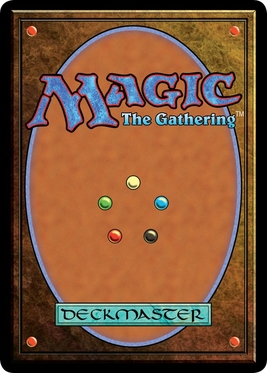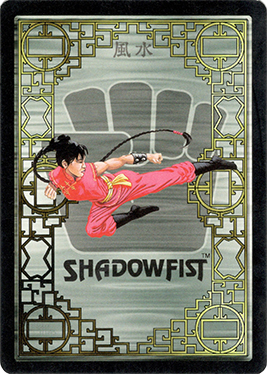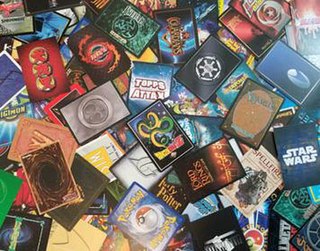
Illuminati: New World Order (INWO) is an out-of-print collectible card game (CCG) that was released in 1994 by Steve Jackson Games, based on their original boxed game Illuminati, which in turn was inspired by the 1975 book The Illuminatus! Trilogy by Robert Anton Wilson and Robert Shea. An OMNI sealed-deck league patterned after the Atlas Games model was also developed.

Magic: The Gathering is a tabletop and digital collectible card game created by Richard Garfield. Released in 1993 by Wizards of the Coast, Magic was the first trading card game and had approximately fifty million players as of February 2023. Over twenty billion Magic cards were produced in the period from 2008 to 2016, during which time it grew in popularity. As of the 2022 fiscal year, Magic generates over $1 billion in revenue annually.
Vampire: The Eternal Struggle is a multiplayer collectible card game published by White Wolf Publishing. It is set in the World of Darkness and is based on the Vampire: The Masquerade roleplaying game.

Middle-earth Collectible Card Game (MECCG) is an out-of-print collectible card game released by Iron Crown Enterprises in late 1995. It is the first CCG based on J.R.R. Tolkien's fictional universe of Middle-earth, with added content from ICE's Middle-earth Role Playing Game.
Magic: The Gathering Limited Edition is the first Magic: The Gathering card set. It premiered in a limited release at Origins Game Fair in 1993, with a general release that August. The initial print run of 2.6 million cards sold out quickly, and a new printing run was released in October 1993. These two runs are known as Limited Edition Alpha and Limited Edition Beta, or just Alpha and Beta for short. Although Alpha and Beta are referred to as different sets by some, officially they are the same set; Wizards of the Coast had expected that people wouldn't necessarily be able to tell the two press runs apart. Beta fixed a number of misprints and errors on cards. The printer accidentally used different corner rounding dies for the second run, resulting in Alpha cards being noticeably distinct in shape and appearance from Beta cards and all subsequent cards. The Beta printing also included a revised rulebook with a number of clarifications, although creator Richard Garfield's short fiction "Worzel's Tale" was removed to make room. The print run of Beta is given as 7.3 million or 7.8 million depending on the source. Despite the set's print run being about three times as big as Alpha's, Beta sold out as quickly as its predecessor.
The collectible card game Magic: The Gathering published seven expansion sets from 1993–1995, and one compilation set. These sets contained new cards that "expanded" on the base sets of Magic with their own mechanical theme and setting; these new cards could be played on their own, or mixed in with decks created from cards in the base sets. With Magic's runaway success, many of the printings of these early sets were too small to satisfy the rapidly growing fanbase. Cards from them became rare, hard to find, and expensive. It was not until Fallen Empires and Homelands that Wizards of the Coast was able to print enough cards to meet demand; additionally, Wizards of the Coast published Chronicles, a reprint set that helped fix many of the scarcity issues with the earliest sets.
Ice Age is a block of three expansion sets in Magic: The Gathering, consisting of the Ice Age, Alliances and Coldsnap sets. It is also the titular first set in the block. The Ice Age set is the eleventh set and the sixth expansion set, previewed at the Canadian Card and Comics Spectacular in early June 1995, and released later that month. Set in the years from 450 to 2934 AR, the set describes a world set in perpetual winter due to the events in Antiquities. Ice Age was followed up June 1996 with Alliances, the fourteenth Magic: The Gathering set and eighth expansion set.; and on July 21, 2006 with Coldsnap. The time period between Alliances and Coldsnap was the longest period of time between the beginning and the completion of a full block in Magic. Originally, the set Homelands, released in October 1995, was the second set in the Ice Age block, but following the release of Coldsnap, Homelands was removed from the block in favor of Coldsnap.
The collectible card game Magic: The Gathering published nine base sets from 1993–2007, also referred to as core sets. The base sets were considered descendants of the original Limited Edition, and shaped the default setting and feel of Magic. These sets consisted entirely of reprinted cards. These cards were generally simpler than cards in expansion sets, omitting multicolored cards, and used only the original abilities and keywords of Magic such as Flying and Trample. This simplicity led to many cards from these sets being considered "staples" of deck design. All cards were given a white border to mark them as reprints, with a few exceptions. From Fourth Edition in 1995 onward, a new base set would come out once per two years in the spring or early summer; for tournament play, that set would be legal for two years in the Standard format until the next core set replaced it.

Shadowfist was created by Robin Laws and Jose Garcia. It was released in June 1995 as a collectible card game (CCG), but was shifted to a fixed distribution of cards as of 2013. It shares the same background as the Feng Shui, a role-playing game created by Laws and Garcia and released the following year. In September 2018 ownership of Shadowfist switched to Vetusta Games.

The Harry Potter Trading Card Game is an out-of-print collectible card game based in the world of J. K. Rowling's Harry Potter novels. Created by Wizards of the Coast in August 2001, the game was designed to compete with the Yu-Gi-Oh!, Pokémon and Magic: The Gathering card games. Its release was timed to coincide with the theatrical premiere of the first film in the series. The game was praised for the way it immersed children in the Harry Potter universe. At one point the game was the second best selling toy in the United States; however, it is now out of print.
Kamigawa is an expert-level block for the Magic: The Gathering game inspired by Japanese myths and revolving around the battle between spirits (kami) and living beings. It consists of the expansion sets Champions of Kamigawa, Betrayers of Kamigawa, Saviors of Kamigawa, and Kamigawa: Neon Dynasty.

Dragon Ball Z Trading Card Game is an out-of-print trading card game based on the Dragon Ball series created by Akira Toriyama. The game was produced by Score Entertainment and uses screen captures of the anime to attempt to recreate the famous events and battles seen in the anime. Score then sold the rights to Panini which eventually ceased publishing.
Time Spiral is a Magic: The Gathering expert-level block consisting of the expansion sets Time Spiral, Planar Chaos, and Future Sight. It is set on the plane of Dominaria, the first time that that plane had been visited since 8th Edition.
The collectible card game Magic: The Gathering has released compilation sets, reprint sets, and box sets over its history. These are distinct from core sets and expansion sets, the most heavily marketed sources of new cards. With the exception of Chronicles, reprint sets generally do not affect tournament legality in supported formats; for example, cards reprinted in the Modern Masters reprint set, while legal for tournament play, did not necessarily cause the card to be included in the "Standard" environment.

Galactic Empires is an out-of-print collectible card game with a science fiction theme. It was published by Companion Games in 1994 until the company's bankruptcy in 1997.

Chaotic is an out-of-print Danish collectible card game brought to the United States by Chaotic USA and 4Kids Entertainment, and distributed by TC Digital Games. It was released along with the open beta version of the online game on October 24, 2007. The card game is also featured in the animated series of the same name. As of 2014, the website is currently closed and the cards are no longer in production.

A collectible card game (CCG), also called a trading card game (TCG) among other names, is a type of card game that mixes strategic deck building elements with features of trading cards. It was introduced with Magic: The Gathering in 1993.
The Rath Cycle is a cycle of three Magic: The Gathering expansions that continues the events of the Weatherlight Saga. Whereas there had previously been no official term for a trilogy of thematically or story-linked expansions, starter decks and booster packs from all three of these sets had the phrase "The Rath cycle" printed on them, firmly establishing "cycle" as the official word of choice and "The Rath Cycle" as the name of this particular cycle. It consists of Tempest, Stronghold and Exodus as the 20th, 21st and 22nd expansion sets, respectively.









